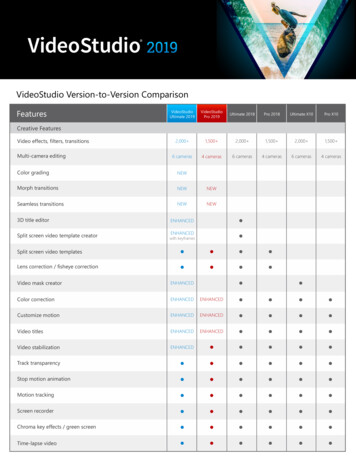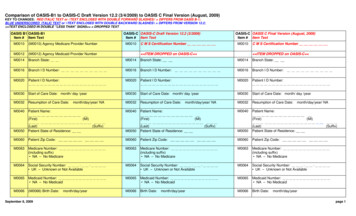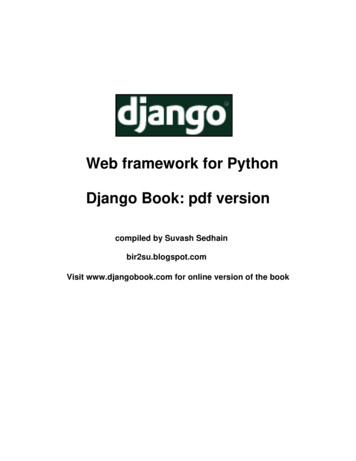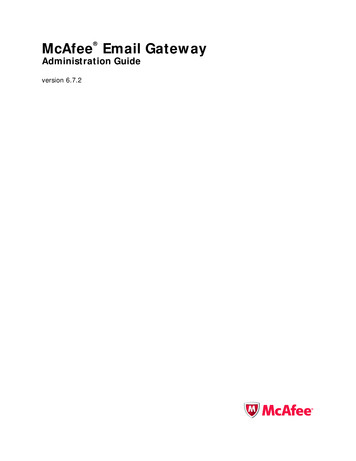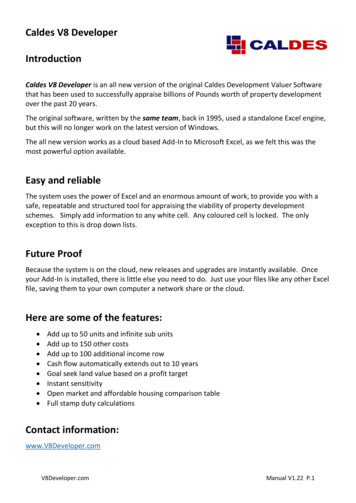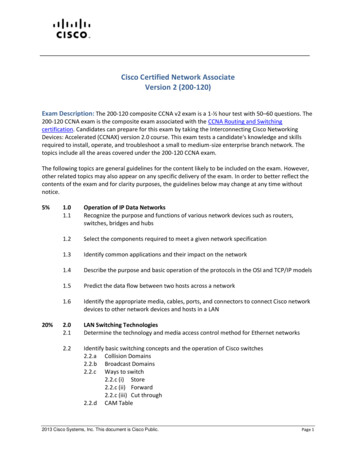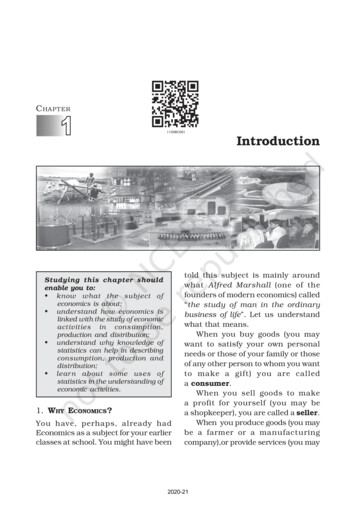
Transcription
C HA P T ER1IntroductionStudying this chapter shouldenable you to: know what the subject ofeconomics is about; understand how economics islinked with the study of economicactivities in consumption,production and distribution; understand why knowledge ofstatistics can help in describingconsumption, production anddistribution; lear n about some uses ofstatistics in the understanding ofeconomic activities.1. WHY ECONOMICS?You have, perhaps, already hadEconomics as a subject for your earlierclasses at school. You might have beentold this subject is mainly aroundwhat Alfred Marshall (one of thefounders of modern economics) called“the study of man in the ordinarybusiness of life”. Let us understandwhat that means.When you buy goods (you maywant to satisfy your own personalneeds or those of your family or thoseof any other person to whom you wantto make a gift) you are calleda consumer.When you sell goods to makea profit for yourself (you may bea shopkeeper), you are called a seller.When you produce goods (you maybe a farmer or a manufacturingcompany),or provide services (you may2020-21
2STATISTICS FOR ECONOMICSbe a doctor, porter, taxi driver ortransporter of goods) you are called aproducer.When you are in a job, working forsome other person, and you get paidfor it (you may be employed bysomebody who pays you wages or asalary), you are called an employee.When you employ somebody, givingthem a wage, you are an employer.In all these cases you will be calledgainfully employed in an economicactivity. Economic activities are onesthat are undertaken for a monetarygain. This is what economists mean byordinary business of life.In real life we cannot be as lucky asAladdin. Though, like him we haveunlimited wants, we do not have amagic lamp. Take, for example, thepocket money that you get to spend. Ifyou had more of it then you could havepurchased almost all the things youwanted. But since your pocket moneyis limited, you have to choose onlythose things that you want the most.This is a basic teaching of Economics.Activities Can you think for yourself ofsome other examples where aperson with a given income hasto choose which things and inwhat quantities he or she canbuy at the prices that are beingcharged (called the currentprices)? What will happen if the currentprices go up?Activities List different activities of themembers of your family. Wouldyou call them economicactivities? Give reasons. Do you consider yourself aconsumer? Why?We cannot get something fornothingIf you ever heard the story of Aladdinand his Magic Lamp, you would agreethat Aladdin was a lucky guy.Whenever and whatever he wanted, hejust had to rub his magic lamp and agenie appeared to fulfill his wish. Whenhe wanted a palace to live in, the genieinstantly made one for him. When hewanted expensive gifts to bring to theking when asking for his daughter’shand, he got them at the bat of aneyelid.Scarcity is the root of all economicproblems. Had there been no scarcity,there would have been no economicproblem. And you would not havestudied Economics either. In our dailylife, we face various forms of scarcity.The long queues at railway bookingcounters, crowded buses and trains,shortage of essential commodities, therush to get a ticket to watch a new film,etc., are all manifestations of scarcity.We face scarcity because the things thatsatisfy our wants are limited inavailability. Can you think of somemore instances of scarcity?The resources which the producershave are limited and also havealternative uses. Take the case of food2020-21
INTRODUCTION3that you eat every day. It satisfies yourwant of nourishment. Farmersemployed in agriculture raise crops thatproduce your food. At any point oftime, the resources in agriculture likeland, labour, water, fertiliser, etc., aregiven. All these resources havealternative uses. The same resourcescan be used in the production of nonfood crops such as rubber, cotton, juteetc. Thus, alternative uses of resourcesgive rise to the problem of choicebetween different commodities thatcan be produced by those resources.Activities Identify your wants. How manyof them can you fulfill? Howmany of them are unfulfilled?Why you are unable to fulfillthem? What are the different kinds ofscarcity that you face in yourdaily life? Identify their causes.Consumption, Production andDistributionIf you thought about it, you mighthave realised that Economics involvesthe study of man engaged in economicactivities of various kinds. For this, youneed to know reliable facts about allthe diverse economic activities likeproduction, consumption anddistribution. Economics is oftendiscussed in three parts: consumption,production and distribution.We want to know how the consumerdecides, given his income and manyalternative goods to choose from, whatto buy when he knows the prices. Thisis the study of Consumption.We also want to know how theproducer, similarly, chooses what andhow to produce for the market. This isthe study of Production.Finally, we want to know how thenational income or the total incomearising from what has been producedin the country (called the GrossDomestic Product or GDP) isdistributed thr ough wages (andsalaries), profits and interest (We willleave aside her e income frominternational trade and investment).This is the study of Distribution.Besides these three conventionaldivisions of the study of Economicsabout which we want to know all thefacts, moder n economics has toinclude some of the basic problemsfacing the country for special studies.For example, you might want toknow why or to what extent somehouseholds in our society have thecapacity to earn much more thanothers. You may want to know howmany people in the country are reallypoor, how many are middle-class, howmany are relatively rich and so on. You2020-21
4STATISTICS FOR ECONOMICSmay want to know how many areilliterate, who will not get jobs, requiringeducation, how many are highlyeducated and will have the best jobopportunities and so on. In otherwords, you may want to know morefacts in terms of numbers that wouldanswer questions about poverty anddisparity in society. If you do not likethe continuance of poverty and grossdisparity and want to do somethingabout the ills of society you will needto know the facts about all these thingsbefore you can ask for appropriateactions by the government. If you knowthe facts it may also be possible to planyour own life better. Similarly, you hearof — some of you may even haveexperienced disasters like Tsunami,earthquakes, the bird flu — dangersthreatening our country and so on thataffect man’s ‘ordinary business of life’enormously. Economists can look atthese things provided they know howto collect and put together the factsabout what these disasters costsystematically and correctly. You mayperhaps think about it and askyourselves whether it is right thatmodern economics now includeslearning the basic skills involved inmaking useful studies for measuringpoverty, how incomes are distributed,how earning opportunities are relatedto your education, how environmentaldisasters affect our lives and so on?Obviously, if you think along theselines, you will also appreciate why weneeded Statistics (which is the study ofnumbers relating to selected facts in asystematic form) to be added to allmodern courses of modern economics.Would you now agree with thefollowing definition of economics thatmany economists use?“Economics is the study of howpeople and society choose to employscarce resources that could havealter native uses in order toproduce various commodities thatsatisfy their wants and todistribute them for consumptionamong various persons andgroups in society.”2. STATISTICSINECONOMICSIn the previous section you were toldabout certain special studies thatconcern the basic problems facing acountry. These studies required that weknow more about economic facts. Sucheconomic facts are also known aseconomic data.The purpose of collecting dataabout these economic problems is tounderstand and explain theseproblems in terms of the various causesbehind them. In other words, we try toanalyse them. For example, when weanalyse the hardships of poverty, wetry to explain it in terms of the variousfactors such as unemployment, lowproductivity of people, backwardtechnology, etc.But, what purpose does theanalysis of poverty serve unless we areable to find ways to mitigate it. We may,therefore, also try to find thosemeasures that help solve an economicproblem. In Economics, suchmeasures are known as policies.So, do you realise, then, that noanalysis of an economic problem would2020-21
INTRODUCTION5be possible without data on variousfactors underlying an economicproblem? And, that, in such a situation,no policies can be formulated to solve it.If yes, then you have, to a large extent,understood the basic relationshipbetween Economics and Statistics.3. WHATISSTATISTICS?At this stage you are probably readyto know more about Statistics. Youmight very well want to know what thesubject ‘Statistics’ is all about.Statistics deals with the collection,analysis, interpretation and presentationof numerical data. It is a branch ofmathematics and also used in thedisciplines such as accounting,economics, management, physics,finance, psychology and sociology.Here we are concerned with datafrom the field of Economics. MostEconomics data are quantitative. Forexample, a statement in Economics like“the production of rice in India hasincreased from 39.58 million tonnes in1974–75 to 106.5 million tonnes in2013–14, is a quantitative data.In addition to quantitative data,Economics also uses qualitative data.The chief characteristic of suchinformation is that they describeattributes of a single person or a groupof persons that is important to recordas accurately as possible even thoughthey cannot be measured inquantitative terms. Take, for example,‘gender’ that distinguishes a person asman/woman or boy/girl. It is oftenpossible (and useful) to state theinformation about an attribute of aperson in terms of degrees (like better/worse; sick/ healthy/ more healthy;unskilled/ skilled/ highly skilled, etc.).Such qualitative information orstatistics is often used in Economicsand other social sciences and collectedand stored systematically likequantitative information (on prices,incomes, taxes paid, etc.), whether fora single person or a group of persons.You will study in the subsequentchapters that statistics involvescollection of data. The next step is topresent the data in tabular,diagrammatic and graphic forms. Thedata, then, are summarised bycalculating various numerical indices,such as mean, variance, standarddeviation, etc., that represent the broadcharacteristics of the collected set ofinformation. Finally, the data areanalysed and interpreted.Activities Think of two examples ofqualitative and quantitativedata. Which of the following wouldgive you qualitative data;beauty, intelligence, incomeearned, marks in a subject,ability to sing, learning skills?4. WHAT STATISTICS DOES?Statistics is an indispensable tool foran economist that helps him tounderstand an economic problem.Using its various methods, effort ismade to find the causes behind it withthe help of qualitative and quantitativefacts of an economic problem. Once thecauses of the problem are identified, it2020-21
6STATISTICS FOR ECONOMICSis easier to formulate certain policiesto tackle it.But there is more to Statistics. Itenables an economist to presenteconomic facts in a precise and definiteform that helps in propercomprehension of what is stated. Wheneconomic facts are expressed instatistical terms, they become exact.Exact facts are more convincing thanvague statements. For instance,saying that with precise figures, 310people died in the recent earthquakein Kashmir, is more factual and, thus,a statistical data. Whereas, sayinghundreds of people died, is not.Statistics also helps in condensingmass data into a few numericalmeasures (such as mean, varianceetc., about which you will learn later).These numerical measures help tosummarise data. For example, itwould be impossible for you toremember the incomes of all thepeople in a data if the number ofpeople is very large. Yet, one canremember easily a summary figure likethe average income that is obtainedstatistically. In this way, Statisticssummarises and presents ameaningful overall information abouta mass of data.Quite often, Statistics is used infinding relationships between differenteconomic factors. An economist maybe interested in finding out whathappens to the demand for acommodity when its price increasesor decreases? Or, would the supply ofa commodity be affected by the changesin its own price? Or, would theconsumption expenditure increasewhen the average income increases? Or,what happens to the general price levelwhen the government expenditureincreases? Such questions can only beanswered if any relationship existsbetween the various economic factorsthat have been stated above. Whethersuch relationships exist or not can beeasily verified by applying statisticalmethods to their data. In some casesthe economist might assume certainrelationships between them and liketo test whether the assumption she/hemade about the relationship is valid ornot. The economist can do this only byusing statistical techniques.In another instance, the economistmight be interested in predicting thechanges in one economic factor dueto the changes in another factor. Forexample, she/he might be interestedin knowing the impact of today’sinvestment on the national income infuture. Such an exercise cannot beundertaken without the knowledge ofStatistics.Sometimes, formulation of plansand policies requires the knowledge offuture trends. For example, aneconomic planner has to decide in 2017how much the economy shouldproduce in 2020. In other words, onemust know what could be the expectedlevel of consumption in 2020 in orderto decide the production plan of theeconomy for 2020. In this situation,one might make subjective judgementbased on the guess about consumptionin 2020. Alternatively, one might usestatistical tools to predict consumption2020-21
INTRODUCTION7in 2020. That could be based on thedata of consumption of past years orof recent years obtained by surveys.Thus, statistical methods helpformulate appropriate economicpolicies that solve economic problems.5. CONCLUSIONToday, we increasingly use Statisticsto analyse serious economic problemssuch as rising prices, growingpopulation, unemployment, povertyetc., to find measures that can solvesuch problems. Further, it also helpsto evaluate the impact of such policiesin solving the economic problems. Forexample, it can be ascertained easilyusing statistical techniques whether thepolicy of family planning is effective inchecking the problem of ever-growingpopulation.In economic policies, Statisticsplays a vital role in decision making.For example, in the present time ofrising global oil prices, it might benecessary to decide how much oil Indiashould import in 2025. The decisionto import would depend on theexpected domestic production of oil andthe likely demand for oil in 2025.Without the use of Statistics, it cannotbe determined what the expecteddomestic production of oil and thelikely demand for it would be. Thus,the decision to import oil cannot be madeunless we know the actual requirementof oil. This vital information that helps tomake the decision to import oil can onlybe obtained statistically.Statistical methods are no substitute for common sense!There is an interesting story which is told to make fun of statistics. It issaid that a family of four persons (husband, wife and two children) onceset out to cross a river. The father knew the average depth of the river. So,he calculated the average height of his family members. Since the averageheight of his family members was greater than the average depth of theriver, he thought they could cross safely. Consequently, some members ofthe family (children) drowned while crossing the river.Does the fault lie with the statistical method of calculating averagesor with the misuse of the averages?2020-21
8STATISTICS FOR ECONOMICSRecap Our wants are unlimited but the resources used in the productionof goods that satisfy our wants are limited and scarce. Scarcity isthe root of all economic problems.Resources have alternative uses.Purchase of goods by consumers to satisfy their various needs isConsumption.Manufacture of goods by producers for the market is Production.Division of the national income into wages, profits, rents and interestsis Distribution.Statistics finds economic relationships using data and verifies them.Statistical tools are used in prediction of future trends.Statistical methods help analyse economic problems andformulate policies to solve them.EXERCISES1. Mark the following statements as true or false.(i) Statistics can only deal with quantitative data.(ii) Statistics solves economic problems.(iii) Statistics is of no use to Economics without data.2. Make a list of activities in a bus stand or a market place. How many ofthem are economic activities?3. ‘The Government and policy makers use statistical data to formulatesuitable policies of economic development’. Illustrate with two examples.4. “You have unlimited wants and limited resources to satisfy them.” Explainthis statement by giving two examples.5. How will you choose the wants to be satisfied?6. What are your reasons for studying Economics?7. Statistical methods are no substitute for common sense. Comment withexamples from your daily life.2020-21
We want to know how the consumer decides, given his income and many alternative goods to choose from, what to buy when he knows the prices. This is the study of Consumption. We also want to know how the producer, similarly, chooses what and how to produce for the market. This is the study of Prod
